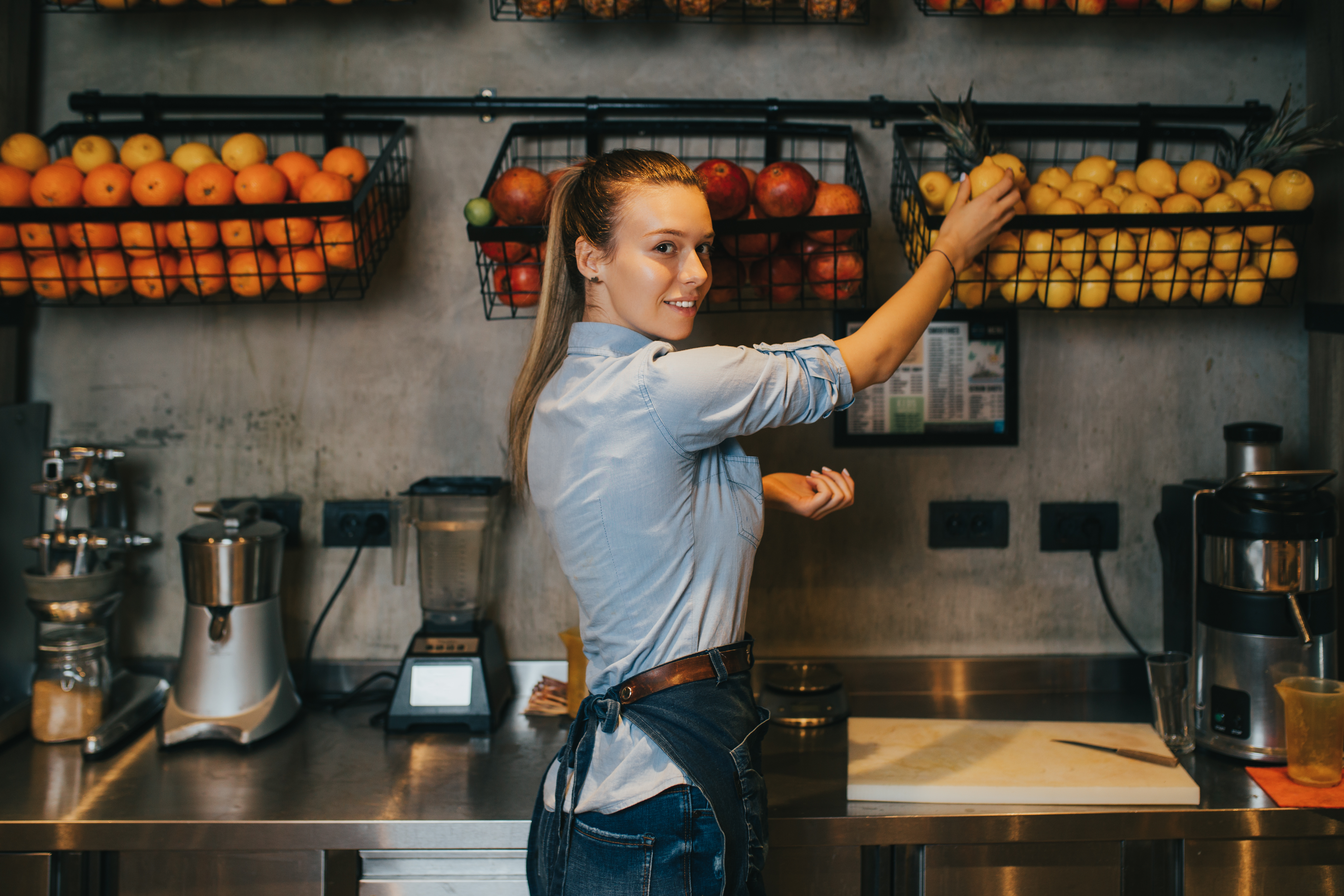
The planning phase of your juice bar startup can feel a little daunting at times, which is totally normal since this is a big endeavor for both new and experienced entrepreneurs. The best advice that we can give is to invest time and energy in having a strategy, especially when it comes to getting your juice bar startup equipment.
Part of your startup strategy will need to be how you are sourcing all of the physical equipment you need to outfit your store. Thus, creating a detailed juice bar equipment list, along with a breakdown of the projected costs, will give you a ‘roadmap’ to follow as you source the best brands and suppliers of commercial tools and appliances to get your startup off the ground.
Based on our experience of over a decade in the juice bar startup industry, we’ve created an essential juice bar equipment list detailing what you’ll need to obtain to be able to operate from day one. Additionally, we’ve created a ‘mock-up’ juice bar equipment price list for you to get a sense of the general range you can expect to budget for.
It’s not as simple as just copy-pasting the list from our article (or any others you come across), as there is a lot to consider that is going to determine what equipment you actually need for the context of your unique juice bar concept.
There are two main elements to get clear on first that will influence the creation of a juice bar startup equipment list, the business model you choose and your menu. In essence, the menu is determined by the business model, though we’ve expanded on each element below for your comprehension.
Are you opening a juice bar purely focused on juice? Or will you also be offering smoothies and food? This will impact on the appliances you’ll need.
Consider the difference between a dine-in cafe concept and a kiosk-style store that’s focused on takeaway juices and grab-and-go products. This will impact how much space you’ll need for storage and prep, and your projected sales quantities, therefore determining what the best size, types, and quantity of commercial equipment like refrigeration and prep-stations you’ll invest in.
For example, if you are creating a space that can fit many people to dine in, or you’re in a location with heavy foot traffic and you project high-sales, this will impact things like how many juicers, blenders, refrigeration, and storage space you’ll need to get to fulfill orders.
This ties into the business model since your vision will determine what products you choose to offer on your menu. A big menu means more space is needed, and potentially more tools to prep the ingredients. Again, the inclusion of additional items like hot and cold meals, a substantial smoothie section on your menu, or offering high-quality cold-pressed juices will all dictate what equipment you will need to purchase.
You need to get clear on your business model and the main elements of your menu (at least your overall vision, like the main offerings, how big it is, etc) before you start to create your equipment list.
If this step of considering the best business model, or designing your menu is one that you’re currently still working out, we can help. We have experienced chefs on-hand to work with clients to create their menu based on the desires of each start-up’s vision. Get in touch with us if you want to discuss what we can do for you on the form at the end of the article.

Now that you are more aware of your business model and menu, below is a comprehensive list of equipment needed to successfully run a juice and smoothie bar business. Again, not all pieces of equipment here may be relevant to your situation, though broadly speaking, most of this equipment in some variation is what you’ll need to budget for to outfit your store.
Obviously, this is the essential piece of equipment that all juice bars must-have. The type of juicer and the number of juices you get will be determined by your menu and business model. Since there is a lot to think about when purchasing a juicer, we offer more in-depth information on what to think about when choosing a juicer in the section below this list.
Most juice bars opt to serve smoothies on their menu too, so a blender is generally necessary. Again, there is a big range of blenders out there, so we also provide more details on how to choose your blender later in the article.
This assists with food prep, especially if you have food menu items and make your own spreads, sauces, etc. Not all juice bars will need a food processor.
Especially if you’re serving smoothies, an ice machine is a necessary piece of equipment, as ice is a common ingredient in smoothie recipes. You might also provide an option to add ice to juices, though generally better quality juices won’t be served with ice since it waters down the product.
Though don’t be surprised if some customers ask for ice to be added, as you may get this request, and having an ice machine allows you to offer that. Some juice bar owners opt to not put ice in smoothies. While it is fine to approach your recipes this way, you will also need to make sure you don’t run up your product costs in this way, as less ice means more produce ingredients.
An industrial cleaning sink is essential for any foodservice business, especially with a sprayer and generally with 3-compartments. This allows for more efficient cleaning of your appliances, utensils, and dishes used for food prep.
Some startups might not consider that having a separate sink for produce would be valuable. We’d recommend keeping them separate, not only for the cleanliness of washing fruits and vegetables without being close to cleaning products and dirty dishes but also for the workflow efficiency in having a separate space dedicated to each task. Many cities require this, so you will need to check with your local health department to confirm this if you are considering circumventing this element (which we do not recommend).
Another sink is often a requirement for almost all health departments (though this is something you’d need to look into for your local region) to wash hands. Depending on the size and layout of your location you could be required to have multiple.
Different sized drying racks are great for air-dry containers, appliances (smoothie jugs), dishes, press bags, and more. These are generally situated near the cleaning sink.
If you project a high capacity of product moving through in your daily operations, it may be worth considering investing in a commercial-grade dishwasher. This wouldn’t mean that you don’t also have the cleaning sinks, as often they are used together in the sink being where your team scrubs the dishes and utensils to then be put into the more heavy-duty dishwasher for thorough cleaning.
These are best suited to juice bars that offer reusable dishes and utensils for customers to eat/drink from (rather than disposable). A note here is that if you choose to get a commercial dishwasher, it could affect the water heater system that your store requires, so take that into account when considering a dishwasher.
Stainless steel countertops are best for commercial kitchens and juice bar production areas. How many you need and their size will definitely vary according to your juice bar size and production methods.
You’ll need a range of different prep tools like knives, peelers, cutting boards, etc. Portion scales, measuring cups, and spoons are also essential for consistency in using your ingredients and making the final product.
This is the broad category for your more detailed consideration of whether you invest in multiple fridges and freezers, and/or a walk-in cool room. Consider your menu size, and the fresh produce you need to have on hand daily (that takes up a lot of refrigeration space). Additionally, consider the refrigeration you’ll need for grab-and-go options that your customer can access.
There are many variations of storage systems and spaces that you’ll use, based again on the business model and the store size. Cupboards, shelving, boxes, and containers for your utensils, appliances, tools, products used for your menu items, and more, all come under the storage category.
There may be more tech equipment that you choose to invest in, such as CCTV and a back-end computer for an in-house office, though definitely an essential piece of tech equipment if a POS system to process orders. Consider how you want to process card payments and how detailed you want the back-end data to be when choosing how complex your POS system is.
You’ll find more freedom in your operations if you choose a mobile POS unit that’s easy to change location if you want to redesign your space, or to carry around the store during events, for example. Having multiple POS systems is also a way to take orders faster.
There will be even more juice bar supplies not detailed in this list of the most common juice and smoothie equipment used, such as toasters, dehydrators, and coffee machines. This is dictated by your menu items.
As mentioned above, there are some key things to think about when choosing your juicer and blender models. This will have a big impact on the cost of this equipment too, with the difference being thousands of dollars.
JUICER TYPE
For juicers, if your menu is based more on fruit juice rather than vegetables, the juicer may not need to be as heavy-duty. If you are looking for high-quality cold-pressed juicing, then you would need that specific device, which is much more expensive than other commercial juicers.
EFFICIENCY
Juicers:
Blenders:
SPEED
Juicers:
Blenders:
NOISE
Some juicers and blenders will be much noisier than others. Loud devices can actually affect your customer’s experience if they are dining-in. If you do choose to have a dine-in juice and smoothie bar, consider investing in models that are known to be quieter. For blenders, that often means a sound enclosure. Note that if your juicing/blending is done in a kitchen space that is away from the dine-in area and ordering counter, the loudness of the device might not be a problem anyway.
CLEANING
Consider how easy the juicers and blenders can be taken apart for cleaning, especially mid-service, as that can affect your service time. This will come up in your research of devices – a tip is to read reviews as often this kind of thing is mentioned in reviews of customers who are using that model.
ADDITIONAL FEATURES
Some devices, for both juicers and blenders (though more specifically blenders), will have additional features and inclusions. There may be additional blade sets, containers, etc which should all be taken into consideration when you’re choosing your device. A simple thing like an extra blending container could definitely make service faster with being able to switch them out to do back-to-back orders.
Below we share the general range that you would expect to spend on equipment. The higher range accounts for the brand’s quality and size/type of equipment that you choose in each category. Again, this all depends on your business model and menu, and when you begin to research equipment for your store, you’ll get a sense of whether you’re in the low or higher-range for your equipment budget.
We’d be happy to share with you a list of trusted brands that we have worked with, and that we recommend to our clients. Reach out to us via the contact form below and we’ll get back to you!
Did you know that you can also lease equipment? We explain the considerations you need to know when making your decision to buy or lease your juice bar startup equipment in the video below.